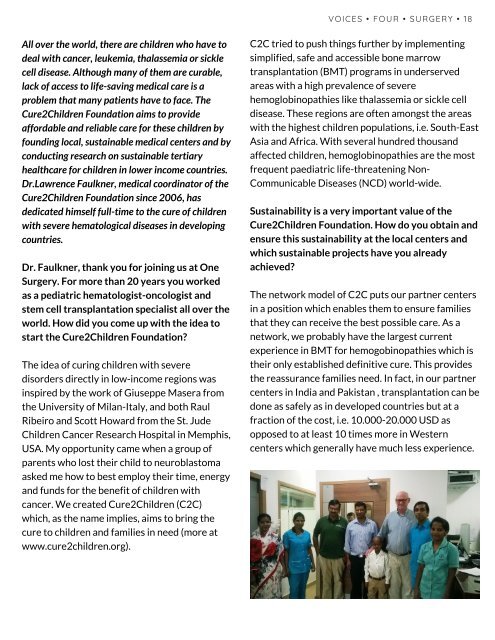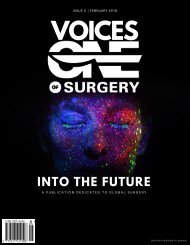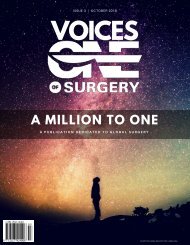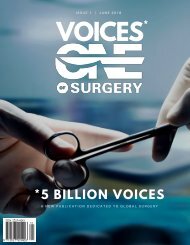Safety First - Voices of One Surgery - Issue 4: December 2018
As we celebrate 10 years of the launch of the World Health Organisation Surgical Safety Checklist and the success it gave, One.Surgery recognises the many challenges that still exist today in the pursuit of providing safe surgery to every patient worldwide.
As we celebrate 10 years of the launch of the World Health Organisation Surgical Safety Checklist and the success it gave, One.Surgery recognises the many challenges that still exist today in the pursuit of providing safe surgery to every patient worldwide.
Create successful ePaper yourself
Turn your PDF publications into a flip-book with our unique Google optimized e-Paper software.
VOICES • FOUR • SURGERY • 18<br />
All over the world, there are children who have to<br />
deal with cancer, leukemia, thalassemia or sickle<br />
cell disease. Although many <strong>of</strong> them are curable,<br />
lack <strong>of</strong> access to life-saving medical care is a<br />
problem that many patients have to face. The<br />
Cure2Children Foundation aims to provide<br />
affordable and reliable care for these children by<br />
founding local, sustainable medical centers and by<br />
conducting research on sustainable tertiary<br />
healthcare for children in lower income countries.<br />
Dr.Lawrence Faulkner, medical coordinator <strong>of</strong> the<br />
Cure2Children Foundation since 2006, has<br />
dedicated himself full-time to the cure <strong>of</strong> children<br />
with severe hematological diseases in developing<br />
countries.<br />
Dr. Faulkner, thank you for joining us at <strong>One</strong><br />
<strong>Surgery</strong>. For more than 20 years you worked<br />
as a pediatric hematologist-oncologist and<br />
stem cell transplantation specialist all over the<br />
world. How did you come up with the idea to<br />
start the Cure2Children Foundation?<br />
The idea <strong>of</strong> curing children with severe<br />
disorders directly in low-income regions was<br />
inspired by the work <strong>of</strong> Giuseppe Masera from<br />
the University <strong>of</strong> Milan-Italy, and both Raul<br />
Ribeiro and Scott Howard from the St. Jude<br />
Children Cancer Research Hospital in Memphis,<br />
USA. My opportunity came when a group <strong>of</strong><br />
parents who lost their child to neuroblastoma<br />
asked me how to best employ their time, energy<br />
and funds for the benefit <strong>of</strong> children with<br />
cancer. We created Cure2Children (C2C)<br />
which, as the name implies, aims to bring the<br />
cure to children and families in need (more at<br />
www.cure2children.org).<br />
C2C tried to push things further by implementing<br />
simplified, safe and accessible bone marrow<br />
transplantation (BMT) programs in underserved<br />
areas with a high prevalence <strong>of</strong> severe<br />
hemoglobinopathies like thalassemia or sickle cell<br />
disease. These regions are <strong>of</strong>ten amongst the areas<br />
with the highest children populations, i.e. South-East<br />
Asia and Africa. With several hundred thousand<br />
affected children, hemoglobinopathies are the most<br />
frequent paediatric life-threatening Non-<br />
Communicable Diseases (NCD) world-wide.<br />
Sustainability is a very important value <strong>of</strong> the<br />
Cure2Children Foundation. How do you obtain and<br />
ensure this sustainability at the local centers and<br />
which sustainable projects have you already<br />
achieved?<br />
The network model <strong>of</strong> C2C puts our partner centers<br />
in a position which enables them to ensure families<br />
that they can receive the best possible care. As a<br />
network, we probably have the largest current<br />
experience in BMT for hemogobinopathies which is<br />
their only established definitive cure. This provides<br />
the reassurance families need. In fact, in our partner<br />
centers in India and Pakistan , transplantation can be<br />
done as safely as in developed countries but at a<br />
fraction <strong>of</strong> the cost, i.e. 10.000-20.000 USD as<br />
opposed to at least 10 times more in Western<br />
centers which generally have much less experience.








